VW – which built its business selling small cars – is building big ones to grow its business.
Models like the new Atlas – which is the equivalent in size, weight and seating capacity of at least two old-school Beetles.
Plus, it has a working heater!
What It Is
The Atlas is a full-size, three-row crossover SUV – and the largest VW to date.
It gives VW something to offer buyers who need room for more than five people – plus their stuff.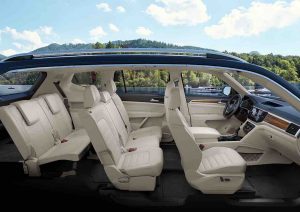
Prices start at $30,895 for the base S trim with a 2.0 liter turbocharged four cylinder engine, eight speed automatic and front-wheel-drive.
A top-of-the-line SEL with a 3.6 liter V6 (not turbocharged) the eight-speed automatic and VW’s 4Motion all-wheel-drive system stickers for $48,395.
Rivals include the new Subaru Ascent – which also happens to be the largest vehicle Subaru has ever offered, for the same reasons.
The Ascent is a little pricier – $31,995 to start – but it comes standard with AWD (optional in the VW) and can seat as many as eight people while the VW maxes out at room for seven.
The Soobie’s third row is tighter, though – 32 inches of legroom vs. 33.7 for the VW – and it has about 10 cubic feet less total cargo capacity (86 cubic feet vs. 96.8 for the Atlas).
The Honda Pilot is another possible cross-shop. Like the VW, it’s available in both FWD and AWD versions. But – like the Ascent – it costs more to start ($31,450) and also has a tight third row (31.9 inches of legroom).
It does, however, come standard with a powerful V6 – extra cost in thew VW – and has a higher standard maximum tow rating: 3,500 lbs. vs. 2,000 lbs. for the four cylinder-powered Atlas.
For 2019 – the second year the Atlas has been offered – the base S trim gets more standard equipment, including automatic headlights and rain-sensing wipers; top-of-the-line SEL trims come standard with a flatscreen Digital Cockpit, upgraded Discover Media navigation system and a standard heated steering wheel.
The mid-trim SE gets three-zone climate control.
What’s Good
Two engine choices – and the choice to buy (or skip) AWD.
Roomier third row – and behind its third row – than rivals.
Lower price to start than rivals.
AWD isn’t available with the standard engine.
Only offered in seven-passenger seating configuration. Ascent and Pilot offer seating for up to eight.
No diesel engine.
Under The Hood
Though the Atlas is big, its standard engine is comparatively small. Just 2.0 liters – which is only slightly bigger than the 1.6 liter engine used in ‘70s-era Super Beetles. But the Beetle’s engine only needed to motivate about 1,700 pounds.
The Atlas weighs more than twice that (4,242 lbs.)
To deal with that, the Atlas’ 2.0 liter engine is boosted by a turbo, which pumps up its output to 235 horsepower (and 256 ft.-lbs. of torque) which is about four times as much power as a ‘70s-era Beetle’s four delivered.
Which accounts for the fact that the two-ton-plus Atlas can get to 60 in 7.5 seconds – nearly twice as fast as a ’70s-era Beetle (which needed about 15 seconds to do the deed, assuming a perfect tune and the wind at your back).
Gas mileage is also better than a ‘70s Beetle: 20 city, 26 highway – in part because the Atlas has an eight-speed transmission with two overdrive gears while the old Beetle had a four speed transmission with no overdrive gears.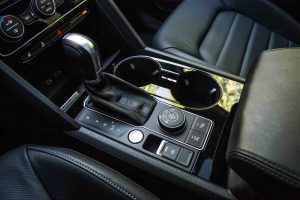
If you want all-wheel-drive, however, you’ll have to buy the optional 3.6 liter V6.
This engine makes 276 horsepower – stronger than the Subaru Ascent’s standard (and only available) 2.4 liter turbocharged four cylinder engine – which makes 260 horsepower. And slightly less strong than the Honda Pilot’s standard 3.5 liter, 280 hp V6.
It can be paired with either FWD or the optional 4Motion AWD system, which features adaptive torque distribution. This is similar to the AWD system in the Ascent; both have the ability to route engine torque not just from front to back but also from side to side. This is a boon for handling as well as traction, because it helps corrects for understeer and oversteer during high-speed cornering and also maintains traction when even just one wheel has it.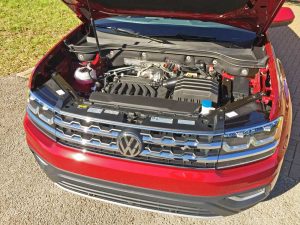
With the 2.0 liter engine and FWD, the Ascent can pull a 2,000 lb. trailer – less than the Ascent’s standard 5,000 lb. maximum tow rating.
The Pilot comes standard with a 3,500 lb. tow rating (5,000 lbs. max tow rating when ordered with the optional trailering package).
But the VW catches up when ordered with the V6.
So equipped, it can pull the same 5,000 lbs. as its rivals.
If you don’t need AWD, you may actually prefer the 2.0 liter engine.
It doesn’t make as much high-RPM horsepower as the optional 3.6 liter V6, but it makes almost the same torque – 256 ft.-lbs. vs. 266 ft.-lbs. – and at just 1,600 RPM vs. 2,750 for the V6.
As 1,600 RPM is basically a fast idle, it means the four’s maximum torque is instantly available – almost like an electric motor. Very little downward pressure on the accelerator pedal is needed to get the Atlas going smartly.
Easily.
Counterintuitively, the four cylinder Atlas is more pleasant to drive than the V6-equipped version, at least in stop and go suburban/urban traffic – precisely because it doesn’t need to work as hard.
It’s possible to drive all the way to work – at the head of the line – without revving the engine past 4,000 RPM.
But aren’t smaller engines harder working engines?
Not necessarily.
Because turbocharging isn’t what it used to be.
The principle is the same. Pressurize the incoming air, to stuff more of it into the engine. More air (plus more fuel) equals more power.
What’s changed is the time it takes to build that pressure – the turbo’s boost.
Engines like the VW’s 2.0 liter four have their turbo snugged up as close to the exhaust ports as possible – rather than farther downstream in the exhaust piping, as used to be typical. This is important because turbos build boost via the pressure of escaping exhaust gas, which drives a waterwheel-like device called a turbine (now you know where the name, turbo, came from). The turbine is connected via a shaft to the compressor, which does just that.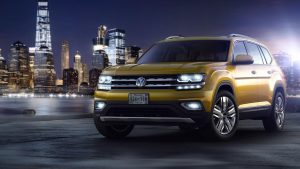
It compresses the incoming air charge, which pressurizes it.
Voila, boost – and almost immediately.
In older-design turbos, you had to wait for the exhaust gas pressure to build before the boost came online. So you got lag – and then a surge.
Here, you just get going, without any turbo drama.
The main everyday driving advantage of the optional V6 is that the Atlas can pull more than twice as much as with the four. But if you don’t need to pull a heavy trailer – and don’t need AWD – you may find the four suits your needs better.
It will definitely suit your pocketbook better.
The V6/AWD adds $3,200 to the price tag of the S trim – and goes up from there.
Oddly, VW charges more for the V6 with FWD when you buy the SE trim – which is one step up the niceness ladder from the base S trim. The base-trim S with the V6 and AWD stickers for $34,095 while the SE with the V6 and FWD stickers for $35,495.
Whether you go FWD or AWD the Atlas has 8 inches of ground clearance – a bit less than the Ascent (8.7 inches, highest in the class) and more than the Pilot (7.3 inches).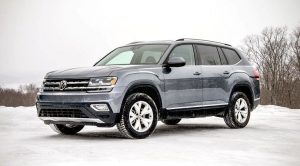
This is arguably as important a feature as AWD when the flakes fall – or rather, begin to accumulate. If your vehicle starts to ride up on packed snow, you’re going to spin wheels – no matter which wheels are powered.
The optional AWD system has driver selectable modes – including Snow, OnRoad, Offroad and Custom Offroad, each one tailoring throttle response and transmission shift points to optimize traction for those conditions.
At The Curb
The Atlas is about the same overall size as the Honda Pilot and Subaru Ascent, but its interior space is allocated differently.
Nominally, the VW seats seven people vs. as many as a theoretical eight in the Honda and Soobie. But the VW’s third row has noticeably more legroom: 33.7 inches vs. 31.9 inches in the Pilot and 32 inches in the Ascent.
It might not seem like much to read about it, but when you’re actually physically back there, it is. 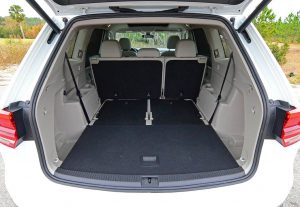
That extra little bit of room makes the VW’s third row more realistic space for two adults rather than two kids. Put another way, the VW can carry seven adults comfortably while the others can carry five adults comfortably . . . plus a few kids.
The VW’s second row (split 60/40) also offers more adjustability.
The seats can be individually moved forward or back through a range of 7.7 inches. If there aren’t any people in the third row, the people in the second row can avail themselves of more legroom than in the first row.
Those second row seats can slide and tilt forward, too – even with child seats installed. The 60/40 second row can also be replaced with a pair of individual captain’s chairs, if you prefer.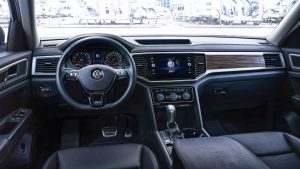
There is also more cargo space in the Atlas – 96.8 cubic feet with both the second and third row seats down vs. 83.9 in the Pilot and 86 in the Ascent. And there’s more room behind the third row – 20.6 cubic feet vs. 17.6 in the Ascent and 18.5 in the Pilot.
That, too, is a significant real-world difference.
You can load the Atlas with more stuff when it is also loaded full-up with people. In the Ascent and Pilot, you may have to pick one – or the other.
Another area of difference is the availability of a very slick-looking 12.3 inch full-flatscreen “digital cockpit” main gauge cluster. It ups the high-end ambiance considerably. It also lets you toggle through a variety of different displays. If you prefer a more traditional “needles and numbers” instrument cluster, you can have that, too.
The available 12 speaker Fender/Panasonic 48 watt/12 speaker audio rig is very good, but even better are the VW’s seat heaters. German cars in general seem to have a hotter “hot” setting than Japanese and American cars. And they stay hot longer (others cycle off sooner).
A massage feature would make them perfect – but that’s not available . . . yet.
All trims – including the base S trim – come standard with at least 18 inch wheels, four USB ports and a 6.5 inch LCD secondary touchscreen for the infotainment system.
SE and higher trims get a larger 8.5 inch screen.
The Rest
VW offers an app called Car-Net that lets you lock/unlock the Atlas’ doors remotely, via your smartphone, as well as check fuel level and even give you directions your Atlas, if you forgot where you parked it.
Just two hairs in the otherwise gemutlichkeit soup:
The Atlas has ASS – automated stop-start. This is the annoying system almost every new car has – not because people buying cars are demanding it but because it helps car companies achieve microcosmic per-car MPG upticks that matter for purposes of CAFE (Corporate Average Fuel Economy) mandates.
ASS automatically shuts the engine off at every red light or whenever the vehicle comes to a stop. It then kicks back on – and that’s just the right word – when the driver takes his foot off the brake or pushes down on the accelerator pedal. While these systems have become less noticeable, they are still noticeable. Off and on and off and on and off and on – maybe a dozen times (or more) on your way to work. And then back home again.
However many times you have to stop that’s as often as the engine will stop – and then re-start.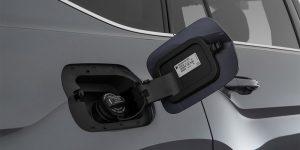
ASS is one of those individually minor aggravations that – cumulatively, begin to grate. There is also the absolute fact of much more load on the starter battery, which will therefore probably not as long – and cost you money. More money, probably, than whatever slight fuel economy gain is eked out by ASS.
Unfortunately, you can’t say no to ASS. And if you want to turn it off you have to push the button for off every time you go for a drive.
The other thing is that you have to feed the punchy little 2.0 liter engine premium unleaded to get the maximum horsepower and torque advertised. If you use regular, you’ll get a bit less.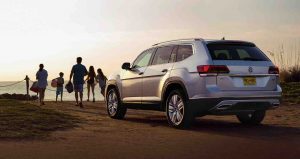
The V6 delivers its advertised horsepower and torque on regular unleaded.
Sadly, there’s no TDI diesel engine – for reasons of federal pedantry and vindictiveness. This is nothing less than tragic – and outrageous.
VW’s force-retired 3.0 liter turbodiesel V6 made 240 horsepower and a stupendous 406 ft.-lbs. of torque and went 5 miles farther on each gallon of fuel than the Atlas’ optional 3.6 liter gas V6, which only makes 266 ft. lbs. of torque.
Be sure to thank Uncle.
The Bottom Line
There’s now more wagen for the volk!
. . .
Got a question about cars – or anything else? Click on the “ask Eric” link and send ’em in!
If you like what you’ve found here please consider supporting EPautos.
We depend on you to keep the wheels turning!
Our donate button is here.
If you prefer not to use PayPal, our mailing address is:
EPautos
721 Hummingbird Lane SE
Copper Hill, VA 24079
PS: Get an EPautos magnet (pictured below) in return for a $20 or more one-time donation or a $5 or more monthly recurring donation. (Please be sure to tell us you want a sticker – and also, provide an address, so we know where to mail the thing!)
My latest eBook is also available for your favorite price – free! Click here. 


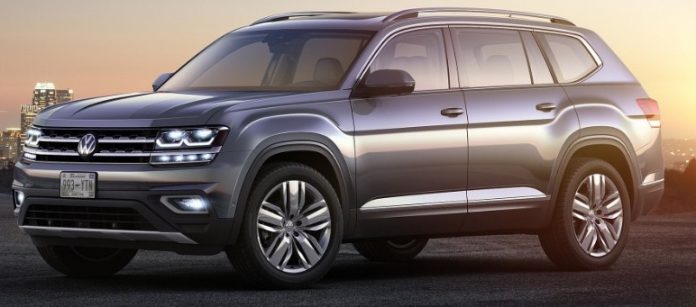

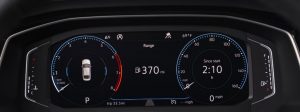
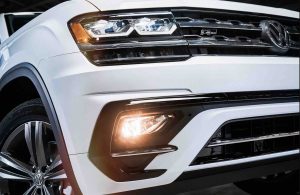
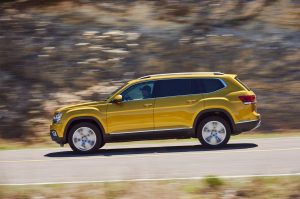







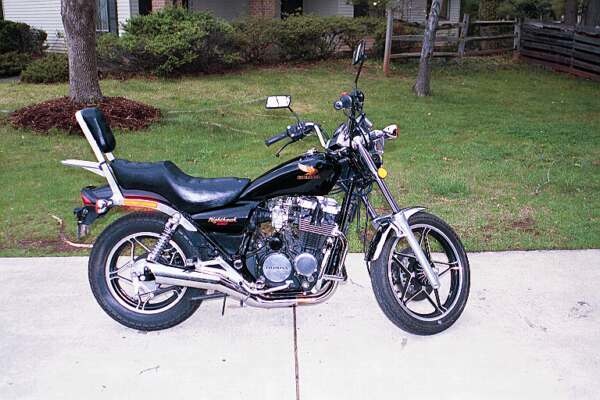
Dieselgate you say?
“Sadly, there’s no TDI diesel engine – for reasons of federal pedantry and vindictiveness. This is nothing less than tragic – and outrageous.” Eric Peters
We recently turned in our B7 TDI Passat to VeeDub simply because the offer. I was not happy to lose a diesel powered vehicle, mainly for the torque of course, and mpg’s.
At the time of the B7 purchase I would have liked to own a ‘Treg’ Touareg but the $55k to $60k stickers said no. Pleased to say, replaced the B7 w a late model Treg3 w 406 foot pounds of torque, up from 238. Won’t be seeing 45-50 mpg’s anytime soon, but nearly 30 for this V6 TDI is not bad.
I have its cousin the Cayenne Diesel, I get routinely 30 or so in the highway even with my leadfoot. I did get the fix, it didn’t seem to do much but make it tad noisier and they messed with the shift points to make it warm up faster.
I interviews and Audio Q8, but coming from my Cayenne with that torque to the Turbo 3.0, kinda ruined it for me. In Europe they put the TDI in the Q8, they get all the good stuff.
I am anxious to see the Cross Sport version I am told that this will be on sale this year. It is shortened version without the 3rd row, it might be a fun toy.
Great review as always Eric
I bought mine in August 2017 close to when they were first available.
I use mine mainly for business and it has been spectacular.
It is terrific on trips, twice from Florida to Colorado as well quite a few weekend trips to the Keys with the grandkids.
I have 57k miles on it so far and it’s been reliable to a fault, and it is actually fun to drive for something that big it holds the road wonderfully and has tight precise steering like using a scalpel.
Mine is the VR6, very disappointed that the TDi is not going to be offered anytime soon. However, I have hopes that after this EV fetish finally jumps the shark the companies will re-think the stupidity of the whole thing.
Engine power of the VR6 is fine for me and my leadfoot, more would always be appreciated, thinking that the old supercharger setup they ha don the VR6 in the old Corrado might be just the thing.
That ASS could be in killer in below zero (F) weather!
Does it automatically shut off in “park” also? If so, how could you let it warm up if you desire? You might get it started in severe cold ONCE, but if it keeps shutting down then the battery might not keep up.
Also, we had a problem with our 2006 Chevy in cold weather, where if we got it started in very cold weather, then if you shut it off without driving very far, it absolutely would not restart – NOT because the battery couldn’t do it, but the computer just couldn’t figure out how to start the car again. All sorts of crazy lights and warnings came on. We learned to drive or idle it at least 15-20 minutes before shutting it off in the cold, except now we have an old jeep and don’t drive the car in the winter at all.
The ASS system doesn’t actually turn it off until the engine is warm, gives me an extra minute or so to remember to turn it off, I developed the habit of hitting it when going for the gear shifter the first time. I miss it sometimes but usually remember before the first stop light.
The first stoplight is at least 60 miles away!
Mine is 2 miles, but the habit is now pretty ingrained.
There is a guy in the FB Atlas group that said he bought a programmer and found a way to disable it, some factor change from 12 to 2 disables it forever.
My wife’s Mercedes has this too but half the time it never kicks in when I expect it to.
LOL the ASS system. I’ll have to start using that.
This is a prime example of Jevon’s paradox, where gains in efficient use of a resource leads to more consumption of a resource, not less. The VW microbus of hippie dream fame with that turbo 4 would probably get 50+ MPG. And be able to climb a 9% grade without having to resort to the reverse gear.
Hi RK,
A hippie bus with 235 hp would (assuming it held together) probably run the 1/4 mile as quickly as a Hellcat!
And get 50-plus MPG…
Jevon’s Paradox is a great explanation story for the Glow-Bull Warming crowd. Little do they know..
Great review as always. The main source we go to for anything car-related (thanks, common sense!)
We have the VW Atlas on our “radar” at the moment.
Question, though – what SUV (or car for that matter) would you recommend for a “family of 5?” With a big, tall “daddy” (6’4″)? Rear-seat legroom is crucial. We have a 2017 Audi A8L which barely makes it. We had to scrap the 2013 Volvo S60 because it was UNUSABLE for tall drivers with kids.
So as you can imagine, interior size is paramount. Especially in the rear.
All kids need car seats for the moment – so that would mean THREE car seats!
Do you recommend a stupid minivan with sliding doors for convenience? Or does the limited rear-seat area make the sliding doors moot for tall drivers?
All this “saaaaaafety” is making it much harder for tall people with children. Your suggestions would be very appreciated!
Hi NJ,
Thanks for the kind words!
I’m 6ft 3 myself – so I very much “get” the head and legroom issues. I sat in all three rows of the Atlas. First and second – more than enough room for a guy my size; in the second row, my knees didn’t come come close to rubbing up against the back of the front seats, even with the front seat (driver’s) adjusted to accommodate someone my height. Third row – serviceable. I wouldn’t want to ride back there for three hours, but it wouldn’t be torture, if I had to.
Crossovers like this are generally better with regard to headroom especially because they usually have lower floorpans than a RWD-based SUV. You also usually have more cargo room vs. the same overall size package SUV, which is another reason for the popularity of this layout.
A minivan will give you even more room – for people and cargo – but if it’s only five of you and you mainly need to access the second row for the kids, I think something like this Atlas could fit the bill.
Thanks! Luckily cargo room ain’t a major issue – we take maybe one long trip a year – sucks regardless.
I saw a full-sized used BUS for sale at an auction. You know, the ones that the country music stars tour in? It was like $28,500. Complete with amenities, etc.
That would solve the cargo issue.
I used to use a Tahoe with the 3rd row, but when taking 3 grandkids, a wife and daughter in trips it got tight, as behind the Tahoes 3rd row there was precious little space. With this guy that is not an issue, 6 people and 3 day weekend worth of luggage was no problem. Even had a kayak on the roof rack!
Tons of legroom for adults in the first two rows. Go for the bigger engine – the 2.0 isn’t enough. (for a chuckle, open the hood on one – there’s enough space in there to add a *second* 2.0).
Since it’s a VW, get the extended warranty. And scope out the service department – ask people waiting for repairs if they’re being well taken care of.
Getting a bus conversion could be fun – but if it comes with a Detroit Diesel 6v92 motor, make sure you can find an old-timer to work on it (they’re two-stroke motors). https://www.youtube.com/watch?v=jW_NQGyqzkc